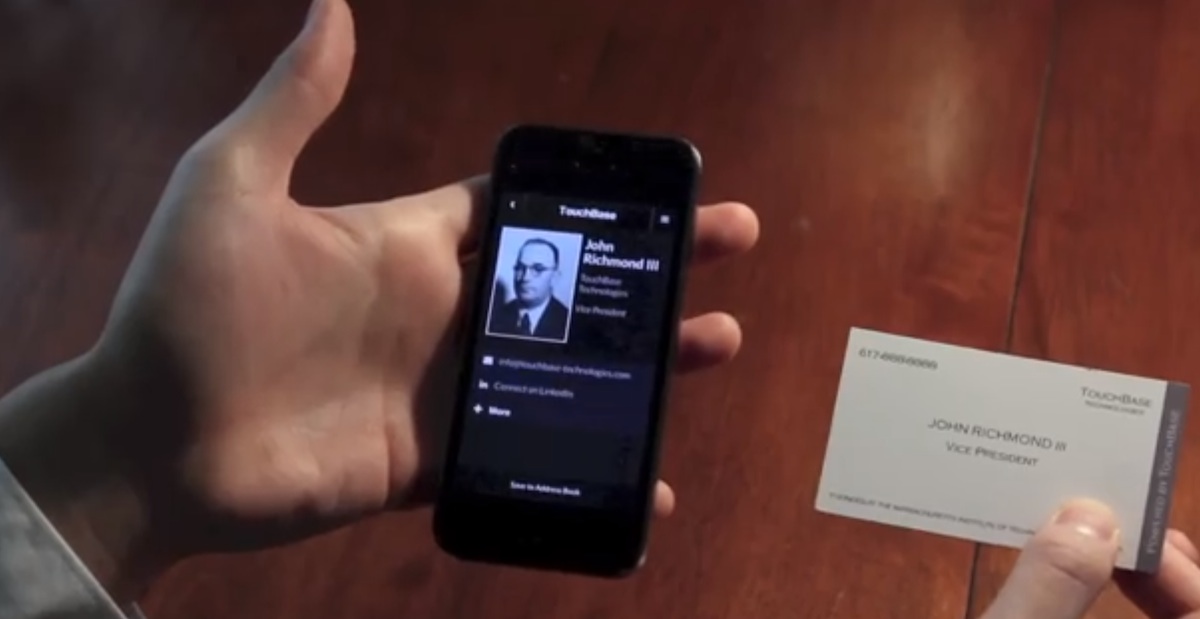What the Tech?: It’s the Revival of the Business Card

Image via YouTube
A slew of companies have been trying to figure out how to bring the business card model into the digital age without losing the tangibility of a piece of paper, but the inventors of TouchBase Technologies think they have the solution pegged.
Like most features on phones, computers, and tablets, TouchBase’s transferrable business card technology is done with the flick of the wrist and the tap of the screen.
Users can store a person’s information into their smartphones by simply placing one of the specialized cards created by TouchBase over their device, and briefly letting it connect. It’s the type of invention that would make American Psycho’s Patrick Bateman’s blood boil.
“It’s kind of like how when you’re going through the turnstiles on the MBTA—you just tap it onto the little black surface. It’s very seamless, and it’s instant,” said Sai To Yeung, TouchBase CEO and a Harvard undergrad.
Yeung understands that other companies have tried to master the new-age version of the business card, but he believes the way in which TouchBase leverages current touchscreen technologies, and maintains the presence of an actual card, offers users the best of both worlds.
“There have been numerous attempts to modernize the business card and really digitize it. One attempt was to get rid of it entirely through ‘Bump,’ but I think it didn’t take off because it strayed too far from the traditional means,” he said.
Other companies tried placing large QR codes onto cards, but according to Yeung’s research, people either didn’t have QR code readers, or didn’t like the look of the large black symbol crowding the real estate of their card. “So that’s another advantage we have, the conductive ink we are embedding isn’t visible. It doesn’t take up any real estate,” he said.
The transition of information from a card to someone’s phone is possible through a unique material inside the card that connects with a landing page on the phone. “What we’re doing is embedding conductive ink within these cards. It’s ink made out of copper or silver that connects electrically. We organize that ink in a unique pattern, and what happens is, when you tap the card on the screen it mimics fingerprint touches onto the screen,” explained Yeung.
The information that can be transferred isn’t just limited to phone numbers and email addresses, however. Yeung said profile pictures, folders, videos, and resumes can also be passed from the card to a person’s smartphone, so people aren’t scrambling to organize materials if they get together for an interview, or business opportunity. “It becomes helpful if you’re an artist or a freelancer, or if you want to share a portfolio of paintings—now you could do that instantly just by handing over the card,” he said.
Like many great entrepreneurial ideas that spawn in the Boston area, TouchBase was born out of MIT. The pair behind the product—Yeung and Jon Warneke, the company’s CTO—were part of the 2013 DreamIt Ventures Accelerator Program. Yeung was enrolled at MIT Sloan, but left to concentrate on the product. Warneke still attends MIT, and is what Yeung refers to as “the brains” behind the complex mathematical algorithms of TouchBase’s unique technology.
“He’s basically a math genius,” he said.
The idea started there, but has since moved forward with an aggressive IndieGoGo campaign that has raised more than $30,000 in less than two weeks.
Once the campaign is over, since it has already exceeded its fundraising goal, Yeung and Warneke plan on sending out links to the people that helped fund their product, so they can create an account, upload contact information, and to design a card. Then, in April, the personalized cards will go into production, before they are shipped out to customers in May. “We are hoping this goes big,” said Yeung.

